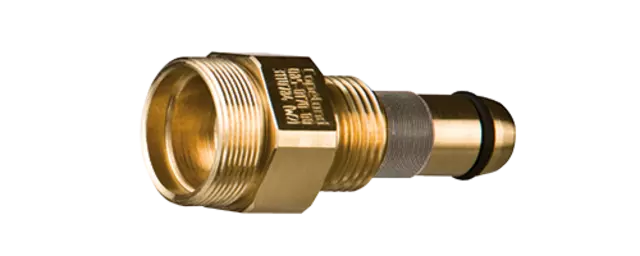Reciprocating compressors are usually equipped with oil pumps to ensure reliable oil lubrication. To guarantee that a sufficient quantity of oil is transported and to prevent damage to the compressor, these compressor types are usually equipped with oil differential pressure switches. If an insufficient oil quantity is detected, the compressor is shut down by the safety chain after a certain period of time.
Precise, reliable measurements prevent errors and increase the service life of the system. The special feature of the KRIWAN products for oil differential pressure measurement is the high flexibility due to the unique two-component system, as well as the compatibility when integrated into existing systems.
The KRIWAN solution for oil differential pressure monitoring consists of evaluation electronics and a screw-in unit that can be mounted and replaced separately. The screw-in part is installed directly in the pump. It measures the pump and suction pressure through internal channels and calculates the difference.


Oil pressure ok
Oil pressure ok
At high pump pressure, the piston in the screw-in part is pressed forward and thus moves away from the evaluation unit. The electronics detect this distance, measuring that there is sufficient oil differential pressure.

Oil pressure low
Oil pressure low
If the pump pressure is too low, the oil differential pressure is not sufficient to move the cylinder. In this case, the sensor immediately reports this to the downstream electronics (on the INT250) or interprets the signal independently (on the Delta-P II), and switches off the compressor after a defined delay time via the safety chain as a precaution.
In addition to the evaluation unit, the two-component system also includes the matching screw-in part. Our screw-in parts for the differential pressure switches are available for two different thread types, 3/4" -16UNF-2A or M20x1.5.

| Article number | Operating pressure | Differential pressure | Medium temperature |
| 02D442S021 | 140 bar | 0,65 bar | -30°C...+90°C |
| 02D443S020 | 140 bar | 0,95 bar | -30°C...+90°C |
02D444 | 60 bar | 0,95 bar | -30°C...+90°C |
| 02D446 | 140 bar | 0,65 bar | -30°C...+90°C |
| Article number | Operating pressure | Differential pressure | Medium temperature |
| 02D555 | 60 bar | 0,65 bar | -30°C...+90°C |
| 02D556 | 60 bar | 0,95 bar | -30°C...+90°C |
| 02D557 | 140 bar | 0,65 bar | -30°C...+90°C |
| 02D557S21 | 140 bar | 0,65 bar | -30°C...+90°C |
| 02D558 | 140 bar | 0,95 bar | -30°C...+90°C |
With the delta pressure switch, the oil differential pressure is monitored independently and reliably without the need for an additional monitoring and control system. It can be directly integrated into the safety chain as it has a potential-free relay. Unlike the Delta-P II, the INT250 can be connected directly to your PLC or a KRIWAN INT69 TML. For example, remote access is possible with some systems. Depending on the system, the installation effort is greatly reduced.
No, the differential pressure was specified together with the compressor manufacturers. Depending on the compressor type, the differential pressure specified by design is 0.65bar or 0.95bar.
Some types of compressors use an oil pump to lubricate the system. The difference between the low- and high-pressure side of the pump is measured. If the differential pressure is present, the pump will operate properly. If the differential pressure is not present, the oil pump is malfunctioning and there is a risk of damage to the compressor.
No, the screw-in parts differ due to different measuring principles. The differential pressure is determined by means of a magnet and Hall sensor, the optical screw-in parts of the level switches determine the level by the different refraction of the light.
What possibilities do the KRIWAN Delta-P II and INT250 oil differential pressure switches offer in practice? Our application sheet gives you interesting insights.